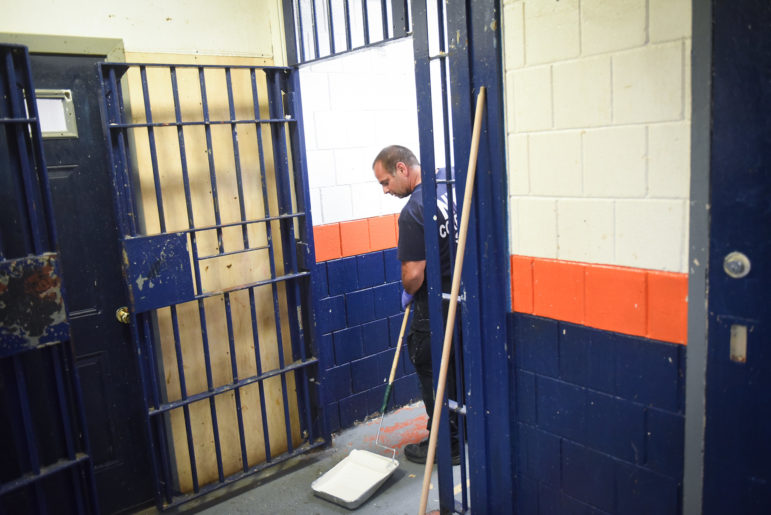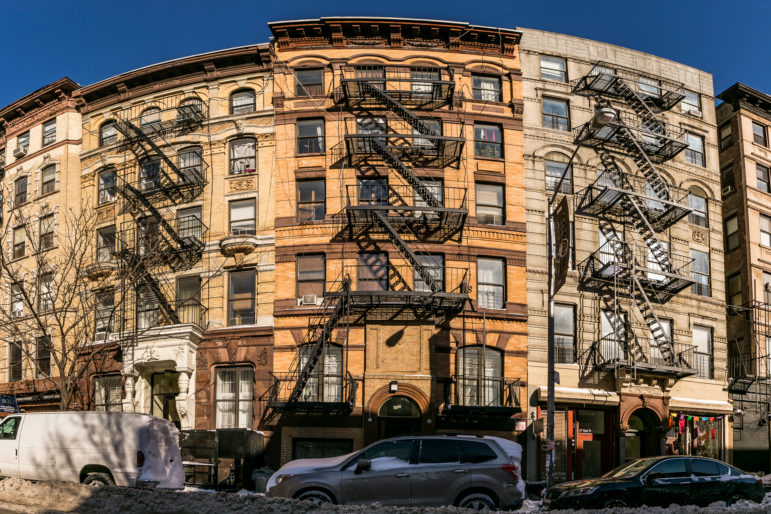“Scientific research very clearly demonstrates that solitary confinement is torture. It also shows that it is counterproductive in achieving its goals because it often increases an inmate’s violent behavior.”

Michael Appleton/Mayoral Photography Office
A staffer paints a cell at Rikers Island in September 2021.Scientific research very clearly demonstrates that solitary confinement is torture. It also shows that it is counterproductive in achieving its goals because it often increases an inmate’s violent behavior. With new legislation on the horizon to formally ban solitary confinement, New York City should take this moment to end the practice once and for all.
Solitary confinement is currently restricted statewide under the HALT Solitary Act, which was signed into law in March 2021. It prohibits isolation of inmates for more than 15 consecutive days or 20 out of 60 days. From a health perspective that is insufficient, as both mental and physical outcomes can appear shortly after isolation and persist even if the inmate was only held for a relatively short period of time.
The draft New York City legislation would go notably further, purportedly allowing solitary confinement for only a few hours if the person being held poses immediate danger. Inmates in these conditions would also be checked on every 15 minutes by medical staff and once an hour by medical clinicians. This proposed approach is aligned with scientific findings on how to limit the adverse impacts of solitary confinement, both to inmates and society. In addition, it would address serious concerns expressed by legislators that New York City has attempted to continue key aspects of solitary confinement by disguising it under a new name—the Risk Management and Accountability System.
There are a long list of serious, well-documented health-related outcomes associated with solitary confinement that emphasize the importance of banning the practice, which is medically considered to be a major stressor. While the impacts are often discussed in terms of mental or physical health, they are generally complex and interconnected. They include, but are not limited to: post-traumatic stress disorder, memory loss, hallucinations, paranoia, anxiety and depression, aggression, self-harm, reduced cognitive functioning, risk of fractures, deterioration of eyesight, cardiovascular disease, and chronic musculoskeletal pain.
These health-related issues can emerge in an inmate who has not exhibited them previously. They can intensify in those with a prior medical history. While the onset period is a few days, the outcomes can last for years. The risk of developing these symptoms, as well as the rates of hospitalization, increase with the number of years spent in solitary confinement.
In terms of mortality, solitary confinement is associated with a 26 percent increased risk of premature death. Solitary confinement originated in the 18th century from a Quaker philosophy of allowing prisoners to be left alone and reflect upon their crimes. However, a report from that same time period found that the “system, fatal to the health of the criminals, was likewise inefficient in producing their reform.” A prison that adopted the practice early on in upstate New York stopped its use as a result.
Today, studies of inmates in solitary confinement show other long-term trends related to an increased predilection to violence, including aggressive fantasies. In fact, experiments with rodents used to research aggression employ social isolation as a tool to induce violence. Data from the New York City Board of Correction supports the hypothesis that violence can follow periods of intense social isolation. A meta-analysis showed that the more recently an inmate was held in solitary confinement, the higher the chance of recidivism.
Proponents of solitary confinement claim that it is necessary to separate a violent inmate from fellow inmates and vulnerable staff to increase safety. Data from Colorado does not support that conclusion. Within a year of limiting solitary confinement to a maximum of 15 days, the number of attacks on staff in Colorado had decreased by 40 percent from 2008–2013.
Furthermore, there are many alternatives to solitary confinement that can help protect inmates and correctional officers in a much more sustainable way. They include anger management classes and mental health therapy for inmates. In the cases where solitary confinement is entirely unavoidable, prisons could practice therapeutic seclusion. This approach strives to let inmates calm down, allows medical professionals the time to make a proper diagnosis, and gives inmates a say in when they feel ready to re-enter to the general prison population.
In the bigger picture, we can also look more broadly at how we approach incarceration. The Netherlands and Germany both have significantly lower incarceration rates than the U.S. They focus on re-socialization and rehabilitation, as well as striving to make life inside and outside of prison similar where possible. Germany also has a rigorous officer training program, “akin to that of social workers and behavior specialists in the U.S.” The officers reward or provide incentives for good behavior. Solitary confinement is used sparingly.
Our current use of solitary confinement in New York City jails isn’t only cruel and inhumane, but also self-defeating. Banning solitary confinement is an important step we need to take to meaningfully address the crisis facing our jails. There’s no better moment than the present to make this happen.
Vaishali Talwar holds an M.Phil. in physiology and neuroscience. She is also a member of Science for New York (Sci4NY), an effort that aims to have policymakers and scientists in New York City work more closely together through project-based interaction.
Nancy Holt, PhD, leads Sci4NY, which brings local scientists and decision makers together to address key challenges facing the city.









One thought on “Opinion: Banning Solitary Confinement in NYC Jails is Long Overdue”
This information is very important, and I think it is necessary for everyone